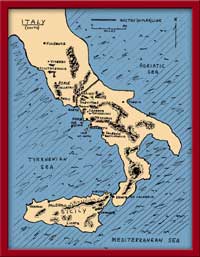
ITALIAN CAMPAIGN
INTRODUCTION TO ITALY
 As the major
combat portion of the 443rd unloaded at Bagnoli Harbor on 20 October it was joined by
Battery A and the Battalion moved from the harbor staging area to an abandoned torpedo
factory. Earlier, completely assembled torpedoes had been moved by underground railway to
a dock from which they were transferred to the nearby Isle d’Ischia, where German
submarines came to be loaded. As the major
combat portion of the 443rd unloaded at Bagnoli Harbor on 20 October it was joined by
Battery A and the Battalion moved from the harbor staging area to an abandoned torpedo
factory. Earlier, completely assembled torpedoes had been moved by underground railway to
a dock from which they were transferred to the nearby Isle d’Ischia, where German
submarines came to be loaded.
During the 10 days the 443rd was in this location, men had many opportunities, some to
meet relatives living in the area and others to visit the largest city seen since leaving
the U.S. Southern Italy had been occupied at one time or another by Greeks plus Saracens
from North Africa. Protruding into the Mediterranean it was fair game for seafaring
adventurers plying the great inland sea over the centuries past. When one looks north to
Rome and the prosperous Tiber River Valley, as well as the country beyond, the terrain
while mountainous, is much kinder and the climate more favorable to agriculture. The north
was invaded over the centuries by the Goths and the Vandals (Germanic tribes) and by the
Huns (from Central Asia). Through the wars the pillaging and the plundering, the
mainstream of history has left marks of unique experiences. Ancient cultures have left
their ruins of buildings, castles, statues, viaducts and aquaducts, and Roman cobblestone
roads. Monasteries and churches testify to Italy’s tremendously influential religious
history. Naples, even from a wartime artist’s view from Sorrento, and the Isle of
Capri, or the high promontory near the torpedo factory, was a beautiful sight as it
overlooked the blue waters of the Bay of Naples under the warm Mediterranean sun. But a
closeup look at wartime Naples was a noisy, dirty, squalid, crowded city with all kinds of
smells. Home for most poor Neapolitans was two rooms with crowded conditions including
livestock (fowl). It was a place to eat and sleep while most social life was outside.
However, in the more exclusive sections of the city the whitewashed Mediterranean villas
had largely escaped the effects of the bombing and shelling. But in the city, each day
began with early morning milk deliveries as cows and goats were led around the streets to
be milked either by the customer or the animal’s owner. Fruits and vegetables from
the country were for sale, and food of all kinds was frequently cooked and eaten on the
streets and in air raid shelters. Americans were intrigued by the garlic odors of such
unusual foods as eels, snail soup, octopus, squid and sea urchins.
And everywhere were signs pointing to "AL Covero" — the air raid
shelters, many of them being in the tunnels where streets went through the many hills of
Naples. The city was Italy’s third largest and its principal port. It was the gateway
to the Italian Theater of Operations and Allied forces of many nations were to be seen in
the streets. Allied bombing during the entire previous summer had badly damaged
Naples’ port facilities and reconstruction had feverishly begun. This made the port a
prime target for German bombers after its liberation. Neapolitans huddled in their
shelters nightly as the attacks continued for another year and the night skies were filled
with a tremendous antiaircraft barrage which rose like a lighted curtain from both ship
and shore installations — mostly too late to hit the German planes as they dive
bombed the port area. U.S. 90mm AA guns seemed to be the only weapon that took a toll of
attacking planes.
|